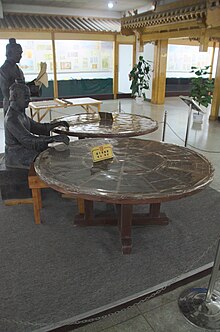Movable type printing
The invention of Bi Sheng was recorded only in the Dream Pool Essays by Chinese scholar-official and polymath Shen Kuo (1031–1095). The book provides a detailed description of the technical details of Bi Sheng's invention of movable type printing:
During the reign of Chingli 慶曆 (Qìnglì), 1041–1048, Bi Sheng, a man of unofficial position, made movable type. His method was as follows: He prepared an iron plate. Then he took sticky clay and cut in its characters as thin as the edge of a coin. Each character formed, as it were, a single type. He baked them in the fire to make them hard. he had covered the plate with a mixture of pine resin, wax, and paper ashes. When he wished to print, he took an iron frame and set it on the iron plate. In this, he placed the types, set close together. When the frame was full, the whole made one solid block of type. He then placed it near the fire to warm it. When the paste [at the back] was slightly melted, he took a smooth board and pressed it over the surface, so that the block of type became as even as a whetstone.
For each character, there were several types, and for certain common characters, there were twenty or more types each, in order to be prepared for the repetition of characters on the same page. When the characters were not in use he had them arranged with paper labels, one label for each rhyme-group, and kept them in wooden cases.
In the next few centuries movable type technology was seldom mentioned or described. Wooden movable-type printing became wide-spread in the Qing dynasty but did not replace block printing, probably because of the expense of creating a font of so many pieces or the low cost of a copyist. The government official Wang Zhen (fl. 1290–1333) improved Bi Sheng's clay types by innovation through the wood, as his process increased the speed of typesetting as well. Later in China by 1490 bronze movable type was developed by the wealthy printer Hua Sui (1439–1513).
